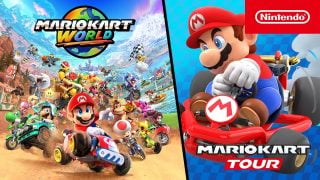Mega Man Legacy Collection is a long-awaited return to the classics that every fan of “The Blue Bomber” has been waiting for. Never having played a Mega Man game in the past, I decided to tackle this game head on and see what all the hype and excitement was about– surely, I thought, there must be something so incredible that I was missing out on because these games and this character are so revered. As a newcomer to the series, getting to play all six games in a row was not only convenient, but exciting as well, knowing that I wouldn’t have to eagerly await the next one as soon as I finished playing. While the game isn’t a 3DS exclusive, it does offer something unique in being the only version on a handheld, as well as offering amiibo support. Mega Man Legacy Collection is a wonderful and refreshing return to classic platformers that old school gamers will not only appreciate, but love.

Prepare for a challenge
I’m not going to bother reviewing all six of the Mega Man games included in this collection separately and in full– the last one featured in the Legacy Collection was released over two decades ago and doesn’t quite warrant a review at this point. Instead, I plan on reviewing the games as a collection and as a series, and how they come together on the 3DS as one.
That being said, the first thing I have to say applies to each game separately as well as the game as a whole: be prepared to die. A lot. I’d always heard about how difficult Mega Man was from friends that had played it, but I always kind of swept their comments under the rug. Any gameplay footage I’d ever seen of it didn’t make it appear any harder than any other platformer, so I was wrongfully dismissive about any claims towards this series’ difficulty. I found myself dying more than I have in any other game I’ve ever played, and often found myself getting extremely frustrated at my own inability to play a simple platformer.

Each game is peppered with enemies that don’t appear to be harder than any other standard video game enemy, especially with a long ranged weapon, but end up being surprisingly annoying, to say the least. What’s worse, none of the six games give you any insight or information upon entering a new stage, meaning how to defeat enemies is up to you to figure out, and you alone. And if a specific enemy is immune to a specific Special Weapon? Good luck.
That was actually something I found myself most frustrated with: the lack of information I was given upon booting up the game. While there are other sections such as a Database for each game within the Legacy Collection, I (just like many others I’m assuming) was too excited to just get into it, especially because I’d never played the series before, and didn’t bother diving deep into these other sections. I instead skimmed through before realizing it was just little information and tips, and then headed straight for the main game. But once you start the main game, you’re just expected to… go. And while, looking back on it now, this is typically how classic platformers started, it still angered me not only for my own lack of knowledge but also for the kids in the past, just starting to learn how to play video games and being given this. In hindsight, I’m quite glad I never played these games as a child, because I see myself easily becoming fed up with them.
Now, don’t get me wrong, I’m not one to shy away from a challenge. In fact, I’m not even berating the game for being hard. I think having a fair amount of difficulty is healthy, and no video game ending should just be handed to a player for doing nothing. I’m simply noting (and warning, for those who might fear a challenge) that, especially if you’ve never played Mega Man before, these games are not forgiving and it may take you a while to get through all six.
Robot Masters
One of the most unique things about Mega Man, and one of the most appealing to me, is the different Robot Masters in each game. The concept is both familiar and unique, similar to superheroes and supervillains with varying superpowers but wholly different in the execution and story behind it.
Unfortunately, in Mega Man’s lack of explanations, this comes with a lack of real plot development. Now, that’s not to say there was no story behind the games, but I found myself turning to the internet for this kind of information a lot, eager to know more but unable to find anything within the games. This is especially an issue in the first three– the second half of the collection has introductions and prologues that do explain things to the audience to some extent, and it was extremely refreshing to see this come into play later on.
The acquisition of any given Robot Master’s Special Weapon at the end of your fight with him is also a great gameplay mechanic that I had a lot of fun with. Whenever I’d start a new stage after receiving a new power, I’d immediately play around with it; I’d see what enemies it was effective (or ineffective) against, and I liked to see what kind of range and look each Weapon had. Additionally, while the game may not tell you what Special Weapon was strong or weak against any given Robot Master, it was extremely satisfying to watch each boss’ health drop at alarmingly fast paces when I used the right Weapon.
The Robot Masters were arguably the best part of this entire game– with six games packed into one, seeing the variety of powers and Weapons was really fascinating and admittedly fun, as well as seeing each Robot Master’s strategy during your fight with him. Despite how tough each one was, their challenges were welcome as I felt that I should be challenged by them, and the win against each one was more satisfying than the last.
Collection extras
Of course, the Legacy Collection wouldn’t be a collection if it didn’t include some things that weren’t exclusive to it. There are a number of features that you’ll only find in this mix of games– some major, some minor. The first, the Challenge section, is a big one.
Challenge Mode in the Legacy Collection is a part of the game separate from the six main games, where over 50 different missions are available to play. This mode stitches together parts of each of the six main games and ties them together in new, exciting, and difficult ways that are fast-paced and can be played again and again. These challenges are also timed, with each challenge already giving you a specific time to beat. Challenge Mode is another wonderful break from the main game, even if it does tend to be difficult, and gives you a way to compete with your friends by seeing who can get the best times. It also does a great job in taking familiar elements and making them into entirely new experiences; even when you may have entire stages memorized, these will throw you for a loop.
The Museum and Database sections of each of the six main games are fun as well. The Museum section is small, but fascinating. In it, you’ll find high resolution scans of things such as box art, manuals, and even cartridges for each of the games! While not offering much to the gameplay experience, it’s cool to be able to see these classic pieces of gaming history that would normally come with these games in the first place. The Database is a little more boring, but much more helpful. In it, you’ll find information on main characters and enemies, including HP and attack power. This isn’t available to you in the middle of playing, though, so make sure you study it!
Lastly, there are a few nice choices in the options sections, such as the ability to change the language, the ability to change between Mega Man or Rockman (depending on your preference), and the ability to put a border around the screen. As the original game is in a square format, you can either have black screen filling in the empty space on both sides, or a border featuring original artwork from the game.
amiibo
It’s no secret that one of the main draws to the 3DS version of this game is the exclusive Gold Mega Man amiibo. Obviously part of the celebration of Mega Man, the gold amiibo is nothing more than the standard Mega Man amiibo from the Smash Bros. line with a gold finish, meaning the standard Mega Man amiibo does work on this game as well. Amiibo integration was, while fun, nothing special, however I will give it props for being interesting.
By using the Mega Man amiibo in the designated section, players are given access to ten new challenges never before seen in any Mega Man game. These challenges were not only interesting, but fun because they were created by fans of the series. For a period of time in September, Capcom had players submit challenges that were created using various sections from all six of the the games, and the ten best that were submitted became featured in the game. While I do wish that the amiibo support was larger in the game, it’s understandable why it wouldn’t be, as it’s not a Nintendo exclusive. The challenges definitely provided a difficult but fun break from the main games that I’d highly recommend if you get the chance.
Gameplay
On the technical side of things, I’m almost afraid to say that the game is lacking. While I wasn’t expecting the smoothest and cleanest game in the world, as each installation within was made more than 20 years ago, I still found it almost too clunky to be forgiven. Sometimes it was the little things (for example, the B button was used to jump, which seems counterintuitive) but sometimes the issues were much deeper than that.
While playing, it often felt like each of the six games were taken from their original cartridges and jammed right into the 3DS without a second thought. Sometimes I questioned if the developers even took a second look at each of the games. There were points throughout each of the six installments that I would find just one or two enemies, or a simple attack from a single enemy, would prove too much for the game to handle and it would lag. Bad. And when you add absurd lag to a video game that’s already notorious for being so difficult, the results aren’t fun. Even playing on the New 3DS, the game struggles hard with handling things that it frequently throws at you. This becomes especially evident with certain minibosses, which are also some of the hardest enemies to defeat.
However, aside from this hiccup, there’s not much else to say about the game. It plays very much like a standard platformer that came from the first era of video games, so if that’s what you’re a fan of, you’ll enjoy this.
I did find that each of the six games and the collection as a whole felt very much at home on a handheld, and I think I’d prefer playing these on a handheld over a standard home console. The graphics aren’t wildly impressive and there’s never too much going on at one time for the game to need to be on a bigger screen, and each of the six entries felt extremely natural in my hands as opposed to on a TV.
One of my favorite gameplay aspects of the Legacy Collection was the inclusion of the extra menu upon pressing the right shoulder button. When you do, you’ll be given a few options, such as restart, quit, add or remove a border, and the like, but the most useful thing about this menu (and the thing I found myself using the most) was the ability to create save states. Instead of having to die and respawn at checkpoints, you can frequently create your own checkpoints, hitting R and clicking “Save” at any point in time. If you die or lose more health than you’d like to in a particular spot, all you have to do is click R again and hit “Load” and you’ll be back where you saved. This can be done as many times as you like and was extremely helpful in my playthrough. And it happened to be one of the things that kept me sane during particularly frustrating sections.
Graphics
Just like the gameplay, the graphics in this collection have a tendency to suffer. Of course, I’m not talking about the standard graphical display of the game. While outdated, the normal graphics of the game are expected for the time period and can’t really be criticized for that.
Even though it’s not quite detrimental, the graphical glitches I found myself often experiencing in the game were borderline unacceptable, with pixels and colors simply acting sporadically, especially towards the edges of the screen. Often, when there was a lot going in a single frame, certain pixels would start to appear transparent or certain things would overlap other elements. While I don’t want to say that this is how the game may have behaved in the past, it would have been much more understandable then. Nowadays, however, this should have been fixed, if not for the fact that it’s just distracting.
Overall, though, the game looks like a classic, nostalgia-inducing 8-bit game that’s sure to bring a lot of older Mega Man fans back. While the colors are a little dull, it definitely adds to the world that the game is set in, and I was a big fan of the way each stage was designed around its respective Robot Master’s motif. The art direction was, in fact, quite enjoyable once you move past the graphical errors.
Unfortunately, the game doesn’t offer very much 3D support for players that want to enjoy it on the 3DS. While the main menus do have some minor 3D effects, as soon as you start up the main games the 3D is completely null. This was a bit disappointing– but also understandable. I don’t think it necessarily detracted from the experience.
Music
Mega Man’s music is fun, energetic, and most importantly, invigorating. I absolutely adored the soundtrack to this game, even if it was on the minimal side (especially in the earlier entries of the collection).
The music that plays the minute Mega Man drops onto the screen in the first stage sets the tone for the entire game, telling you exactly what you’re getting into and how you need to approach it. There’s nothing about it that implies this will be an easy game, and instead the music tells you that you’re in for a fight, and the enemies are not going to be giving up easily. While there’s not a ton to say about the music, as none of it as even the slightest bit new, I can say I enjoyed it.
If you’re looking to explore Mega Man’s music as a whole, there’s a wonderful section in the home menu called the Music Player that gives you access to all the music and sound bytes from the game.
Final thoughts
Mega Man Legacy Collection is by no means a bad game. While it does suffer in some areas because of its ported status and the entries’ datedness, it makes its transition into a re-released classic (or classics) very smoothly. I’m also excited that I finally got to experience the Mega Man series and get a first hand impression of what all the hype was about. I’d strongly suggest looking into getting this game on the 3DS, as it really does feel great as a handheld game, as well as giving you the exclusive amiibo content, even if it’s not amazingly extensive.
In putting out these first six games in an easy and accessible way, Capcom is really giving Mega Man the potential to widen its fanbase and get an entirely new generation on board with the series, which is huge (especially in conjunction with Mega Man’s inclusion in Super Smash Bros.). Hopefully the release of Mega Man Legacy Collection will be able to usher in a new era of gamers who are interested in exploring older, and more difficult, titles.
Leave a Comment








